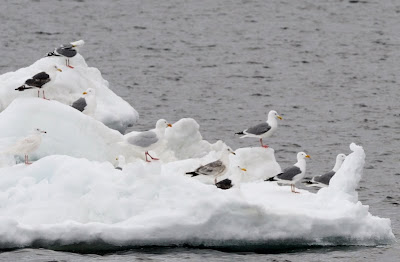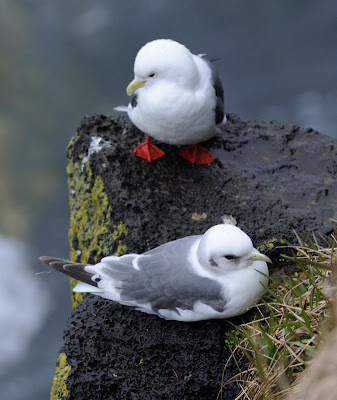I suspect right at the moment there is probably little more than the occasional Raven floating around Gambell. In the late spring however a fairly wide variety of breeding and migrant gulls can be found around this Alaskan outpost. Being located in the Bering Sea just 38km from Siberia obviously the resident gulls have a distinctly Eurasian flavor with the migrants being mostly high arctic nesters.
Siberia as seen from Gambell across the Bering Sea
The Yupik village of Gambell is on the north western tip of St. Lawrence Island and has been a mecca for ABA birders for over 25 years. Although conditions were originally very rustic they are now very decent. A variety of tour companies lead trips to Gambell and because of the very complicated logistics I would suggest this is certainly the easiest if not the cheapest way to bird Gambell. I travelled to Gambell as well as Nome, Adak, Barrow and the Pribolofs last spring with High Lonesome and it was a great adventure with great leaders and excellent organization and support. Accommodations and meals were great (considering the locations) on all parts of the trip. Birding Alaska is always a bit of a crap shoot given the weather and off beat locations. Stories of people being stranded in various places abound and I felt I was lucky to have only experienced a few short delays.
Whale bones and seal meat at Gambell
Going to Gambell is more than just a birding trip it is a fascinating cultural experience. The relationship between the birding community and the Yupiks is very interesting and complex. Given that one can easily stay out to 2 AM not only birding but taking pictures Gambell can be exhausting especially for the more obsessed types such as myself. Luckily no matter how late you stay up you will have lots of company as the Yupiks- adults and children make good use of there brief spring/summer.
Yupik family on 4 wheeler around 2:00 AM
The best spot for studying gulls at Gambell is at the sea watch. On some occasions giant icebergs loaded with roosting gulls would roll by like floats in a parade. Glaucous Gulls are probably the commonest species followed by the local "Herring" Gull which I will refer to subsequently as Vega Gull.
Parade of gulls at Gambell sea-watch including Glaucous, Vega and Slaty-backed
According to Howell and Dunn the subsp. of Glaucous Gull on the Bering Sea Islands is pallidissimus. Barrovianus is found on mainland Alaska while to the east in the Canadian arctic hyperboreus (which is felt to be a seperate subsp.- leucretes by some) the nominate subspecies is native. Pallidissimus averages the palest and largest of the subsp. The differences between these subsp. are subtle.


Adult Glaucous Gull in high breeding plumage
Although one often has other things on your mind (like seeing the Green Sandpiper before one of the native kids clips it with his .22) at Gambell I did spend some time studying the commoner breeding sp. It was great to see the Glaucous Gulls in high breeding plumage - probably something you will never see at home (unless you live on Baffin Island).

Adult Glaucous Gull in high breeding plumage
The above pictures illustrate the characteristic Glaucous Gull features present during high breeding season including the lemon yellow to yellow-orangish eye, the orange to pinkish-orange orbital ring. the pink-flesh coloured gape and the deep orange bill with red gonys. A real stunning combination.
Adult Glaucous Gull in high breeding plumage
Vega Gull known taxonomically according to the AOU ( and the relatively liberal BOU) as Larus argentatus vegae and by others as Larus vegae is a very localized breeder in North America breeding regularly only on St. Lawrence Island. Gambell is one of the few North American birding sites were one can study numbers of this taxon. It is common in the late spring.
Adult Vega Gull with adult Glaucous Gulls
It was somewhat of a disappointment that the overwhelming majority of the Vega Gulls present were adults in breeding plumage about the least likely version to end up straying into our territory. I did not see a single first cycle bird unfortunately.

Adult Vega Gulls in flight
The adult Vega Gull is relatively simple to differentiate from L.a. smithsonianus with its dark black eye, and significantly darker upperparts (Kodak 7-8 vs. 4-5). Subtler difference include an orangish-red orbital ring in vegae as opposed to a yellow- yellowish-orange in smithsonianus along with minor differences in the primary patterns and of course the leg/foot color.
American Herring Gull ( L.a. smithsonianus )-high breeding plumage
Vega Gull (L.a. vegae)- almost high breeding plumage
The above photos illustrate nicely the clear difference in the color of the orbital ring between these two taxon.
The wing and primary pattern differ in a couple of definitive ways other than just the shade of gray. Vega Gull clearly has a broader trailing edge that merges into a "string of pearls" (white tongue- tips) at the inner primaries. This is very similar in effect to the sympatric Slaty-backed Gull. Although the white tongue-tips may be seen in American Herring Gull ( see second example below) the amount of white is usually quite reduced.

Adult Vega Gull- wing closeup

Adult American Herring Gull - wing closeups
Adult Vega Gull- wing closeup
Adult American Herring Gull - wing closeup
On to the legs. Once again Vega seems to share another trait from Slaty-backed Gull. This is quite a fascinating phenomena and I wonder if this is based on convergent evolution. The Vega Gull has deep pinkish red feet with lighter pink legs. Much brighter and more saturated than any other of the "Herring" Gulls.

Adult Vega Gulls showing bright reddish pink feet and legs
Adult American Herring Gull showing dull pink feet and legs
The third large Larus species to be found on St. Lawrence Island is L. schistisagus more commonly known as Slaty-backed Gull. Howell & Dunn noted breeding in the Western Aleutians and at Cape Romanzof but not on the Bering Sea Islands. They mention it is locally uncommon on St. Lawrence Island and the Seward Pennisula in the fall. Numerous birds were present during my visit including several adults and a third cycle bird.
Adult Slaty-backed Gull and Adult Glaucous Gull
I remember a discussion line on ID Frontiers last year in which Gary Rosenberg commented on the universally very dark-mantled Slaty-backed Gulls in Alaska and expressed concern that the lightness of the mantle of several of the birds identified in the Lower 48 seemed out of range in his experience. After viewing several adult Slaty-backeds in Gambell I can see his point. These birds are very dark- backed. Ujihara talks about the real variation and the confounding variables in this trait on his website:
http://www23.tok2.com/home/jgull/081204Slaty/slaty2.htm
The Vega Gulls also appear very dark in Gambell and at first glance it is easy to think these are Slaty-backeds. I suspect Gambell Slaty-backeds are at the dark end of the spectrum and that the usual light conditions at Gambell intensifies the effect. Note how dark the Vega Gulls in the following photo appear and the Slaty-backs appear jet black.
Slaty-backed, Vega and Glaucous Gulls
I have include some Slaty-backed flight shots


Adult Slaty-backed Gulls in flight
Third year Slaty-backed Gull
Like the Vega Gull the Slaty-backed has bright pinkish-red feet however Vega Gulls seem to have darker red feet and duller pink legs at least in breeding season while the Slaty-backeds seem to have the same bright pinkish -red colour to both feet and legs.
Slaty-backed Gulls have a reddish orbital ring very similar to Vega. Of course the Slaty-backed Gull has a very light eye usually with a yellowish tinge in breeding plumage while the Vega Gulls eye is usually very dark.
Third year Slaty-backed Gull showing bright pink feet and legs
Adult Slaty-backed Gull showing lemon yellow eye and reddish-orange orbital ring
I had been in Gambell for about 5 days and had yet to spend any real time photographing gulls. I was heading back from the sea watch that evening around 10:30 pm when I noted a feeding frenzy of gulls just offshore. I thought this would be a nice opportunity to get some flight shots and headed to the party.
I was there for 15-20 minutes when out of the blue an adult Ivory Gull swooped in a joined the frenzy. It was fluttering about just off shore as I tried to calm myself to get some pictures.

Adult Ivory Gull
It wasn't long before I realized that I was in a bit of a "situation". I was actually one of the few people in our group who had seen an Ivory Gull. Here I was about 20 minutes away from the lodge with no radio and an Ivory Gull at arms length. I could imagine the reception when I recounted the story and shared the pictures with the group. Just as I decided I better head back and raise the group and flottilla of ATVs crested the hill and I waved the group over. Apparently the Ivory Gull had swooped by the sea watch on the way to the feeding frenzy and had been reported back to the group. Saved by the bell.


Adult Ivory Gull
It put on a good show for the group then vanished never to be seen again at least by us.
We saw two other gull species during our time at Gambell. Black-legged Kittiwake was a fairly regular fly-by at the sea watch and an adult breeding plumage Black-headed Gull spent a day and a bit south of the lake but was never within distance for photographs. We didn't see a Sabine's Gull but I believe it is a regular migrant. To my disappointment we did not see a Ross's Gull. It is not to be expected at Gambell but should always be hoped for.
I thought I would share a few more gull pictures from various Alaskan destinations to finish off:
First cycle and Adult Black-legged Kittiwake- Little Tanaga Strait, Aleutians

Adult Galucous-winged Gull- Little Tanaga Strait, Aleutians

Adult Mew Gull- Anchorage

Adult Mew Gull- Anchorage

Adult Sabine's Gull- Barrow
Adult Black-legged Kittiwake- St. Paul Island

Adult Red-legged Kittiwake - St. Paul Island
Adult Red-legged Kittiwake - St. Paul Island

Adult Red-legged Kittiwake - St. Paul Island

First cycle and Adult Red-legged Kittiwake - St. Paul Island
First cycle and Adult Red-legged Kittiwake - St. Paul Island
Red-legged Kittiwake was the technically (given the current taxanomical status of Vega Gull) the only "lifer" gull I saw in Alaska and I enjoyed it immensely. Its a most unusual bird with the most restricted breeding range of any gull. Traditionally most of the world population nested on St.Paul and St. George Islands (the Pribilofs). According to Dunn & Howell the population in the Pribilofs has declined by as much as 50% since the mid 70s. Inversely populations in the western Aelutians have been on the increase.
There were no Ross's Gull at Barrow either. I also missed Kamchatka Gull ( L. (canus) kamtscatschensis) the Siberian version of the Mew Gull considered by many authorities to be a distinct species. I am hoping to see the Kamchatka Gull next spring somewhere between Adak and Attu. If anyone wants to come along there may be a spot left on the boat - talk to John Puschock for the details.
Kirk Zufelt
zufelt_k@shaw.ca

















































































